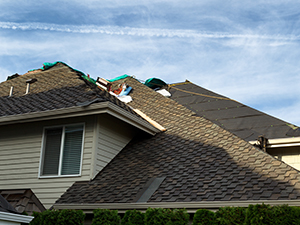
Your roof is your home’s first line of defense against the elements, from scorching sun and heavy rain to wind, snow, and hail. Over time, even the most durable roofs can wear out, and repairs may no longer be enough to keep them functioning properly. That is when a residential roof replacement becomes necessary.
While the idea of replacing your roof can seem daunting, understanding the process and knowing what to expect can make it far more manageable. A properly installed new roof by experts, such as our team at Sully-Jones Roofing, not only enhances your home’s protection but also boosts curb appeal and resale value in La Mesa, California. Call us today on 619-444-0150 for an estimate.
What Is the Process of Residential Roof Replacement?

Residential roof replacement is a multi-step process that involves removing the old roofing materials and installing a new system that provides better durability, weather resistance, and performance. Here’s a step-by-step look at what the process typically includes:
1. Initial Inspection and Assessment
The process begins with a thorough inspection by a professional roofing contractor. They assess the roof’s condition, identify any underlying issues, and provide a detailed estimate and timeline.
2. Choosing Roofing Materials
Once the assessment is complete, you will work with your contractor to select materials. Common options include asphalt shingles, metal, wood shake, clay tiles, and composite materials, each with its own pros and cons.
3. Scheduling and Permits
Your roofing contractor will schedule the work and secure any necessary building permits, which may be required depending on your local codes and homeowners’ association rules.
4. Tear-Off of Old Roofing
The crew removes the existing shingles or roofing materials, exposing the roof deck underneath. This step is crucial to inspecting the structural integrity of the roof and identifying any hidden damage like rot or mold.
5. Deck Inspection and Repairs
After the tear-off, the decking (the base of your roof) is inspected. Damaged or rotted wood is replaced to ensure a stable foundation for the new roof.
6. Installation of Underlayment
A water-resistant or waterproof underlayment is installed to act as a barrier against moisture and protect the decking.
7. New Roofing Installation
Shingles or other roofing materials are installed in layers according to manufacturer specifications and local building codes. Flashing, vents, and ridge caps are added as needed.
8. Cleanup and Final Inspection
Once the roof is installed, the crew cleans up debris, nails, and materials from your property. A final inspection ensures everything is installed correctly and safely.
What Factors Make the Process Longer?
Though many residential roof replacements are completed in a few days, several factors can influence the duration:
Roof Size and Complexity
Larger roofs or those with complex architectural features like dormers, chimneys, or skylights take longer to replace.
Weather Conditions
Rain, high winds, or extreme temperatures can delay installation. Most contractors schedule work during favorable weather windows.
Material Type
Some roofing materials are quicker to install than others. For example, asphalt shingles go on faster than clay tiles or slate.
Structural Repairs
If the roof deck is damaged and requires significant repair, that adds time to the overall job.
How Are Residential Roofs Replaced?
Roof replacement is a careful process that ensures long-term performance and protection. Here is a closer look at how it is done:
Preparation: The crew protects landscaping, driveways, and surrounding areas with tarps and plywood.
Tear-Off: Old shingles and underlayment are removed, often using tools like roofing shovels or tear-off bars.
Decking Check: Exposed wood decking is examined and replaced if needed.
Underlayment Installation: A waterproof or synthetic underlayment is rolled out across the entire roof surface.
Flashing and Drip Edge: Metal flashing is installed around roof penetrations and edges to direct water away from vulnerable areas.
Shingle or Material Installation: Starting from the bottom edge, shingles or other materials are nailed or secured in overlapping rows.
Ventilation and Ridge Cap: Roof vents are installed to allow air circulation, and ridge caps seal the top of the roof.
Conclusion
Residential roof replacement is a significant but necessary investment in your home’s safety, comfort, and value. While the process may seem complex, our experienced team at Sully-Jones Roofing will guide you through each step, ensuring minimal disruption and long-lasting results.
By understanding how roof replacements are performed, the factors that influence timelines, and how to prepare, you can make informed decisions that protect your home for decades to come. Call our La Mesa, California team today at 614-444-0150.
FAQ
How long does a residential roof replacement take?
Most replacements take 1–3 days, depending on the size and complexity of the roof, weather conditions, and the type of materials used.
Will my homeowner’s insurance cover roof replacement?
If the replacement is due to storm or accidental damage, it may be covered. However, replacements due to age or wear and tear are typically not covered.
What type of roofing material lasts the longest?
Metal and slate roofs can last 40–100 years, while asphalt shingles typically last 20–30 years.
Do I need to move out during roof replacement?
No, most homeowners stay in their homes during replacement. However, it can be noisy, and some prefer to make alternate arrangements during the installation.
How do I know if I need a full replacement or just a repair?
If your roof is older than 20 years, has widespread damage, or has recurring issues, replacement may be more cost-effective than repeated repairs.
